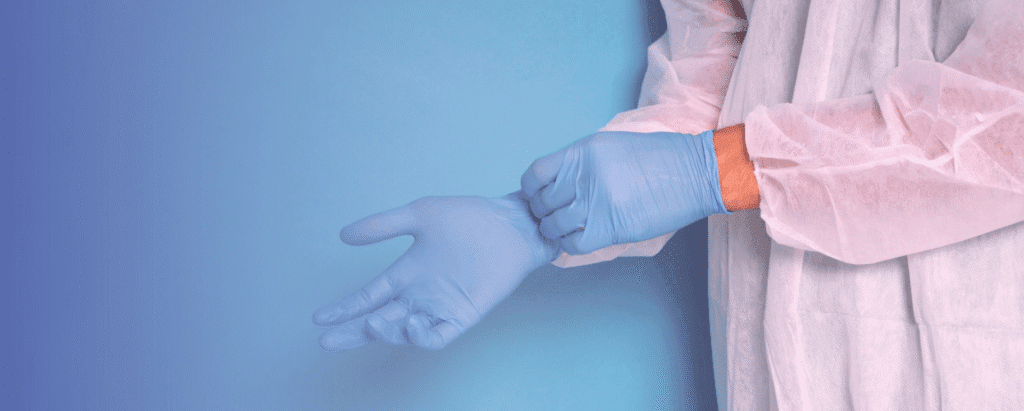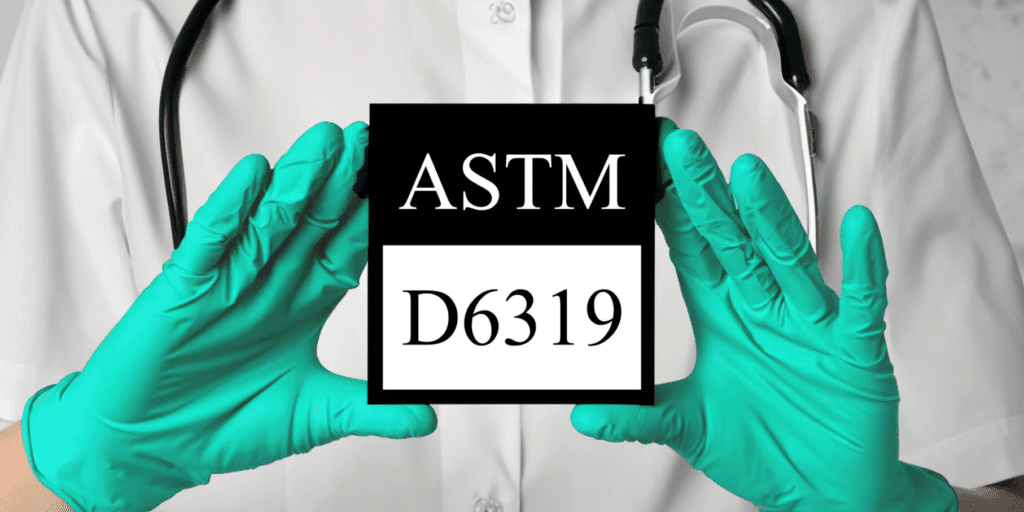Disposable gloves which are used as personal protective equipment must follow specific standards according to different markets.
let’s go straight to this article’s point, there are two standard series you should know before purchase:
1 Conformite Europeenne(CE standard)
2 American Society for Testing Materials(ASTM)
EN455
Disposable medical gloves which were used to stop virus infection, will be tread as medical device and follow EN 455. This standard covers various materials and both sterile and non-sterile products.

Medical gloves intended for surgical procedures are considered to be Medical Device Class IIa. This requires approval and certification by a Medical Device Notified Body and a sterile assessment. These products should be registered with the local health organization responsible for managing the device.
Below is a summary of EN 455 by sections with test descriptions or requirements.
| Test methods | Test description | Description of requirements |
| EN 455-1 | Freedom from holes | Water tightness test based on AQL 1.5 for examination gloves, 0.65 for surgical gloves |
| EN 455-2 | Physical properties | Size requirements |
| Force at break (before and after challenge testing | ||
| Surgical gloves: ≥ 9N | ||
| Examination/Procedure gloves: ≥ 6N | ||
| Thermoplastic gloves: ≥ 3.6N | ||
| EN 455-3 | Biological evaluation | Tests for evaluation: • EN ISO 10993-1 general principles on biological evaluation of medical devices • EN ISO 10993-5 Biological evaluation of medical devices-Part 5: Tests for in vitro cytotoxicity • EN ISO 10993-10 Biological evaluation of medical devices-Part 10: Tests for irritation and skin sensitization |
| Powdered level | For powder-free gloves: ≤ 2 mg/glove | |
| Chemicals | Upon request– Disclose list of chemical ingredients either added during manufacturing or known to present in the product that are known to cause adverse health effects | |
| Endotoxins | For gloves that are labelled with “low endotoxin content” | |
| ≤ 20 endotoxin units per pair of gloves | ||
| Proteins, leachable | Monitor the process limit of leachable protein in the finished gloves containing natural rubber latex by modified Lowry method | |
| EN 455-4 | Shelf life determination | Assessment criteria for determining shelf life so suitable “best before” date may be indicated. |
EN 373

EN ISO 374 specifies the requirements for protective gloves intended to protect the user against dangerous chemicals and micro-organisms.
Summary of EN ISO 374 by sections with test description or requirements.
| Standard | Test description | Requirement |
| EN ISO 374-1 | General requirement | Shall comply with EN ISO 21420 clause 4, clause 5, clause 7 |
| Penetration | No leak for air leak test | |
| No leak for water leak test | ||
| Degradation | Test as claimed in the marking and reported in the user instruction | |
| Permeation | Type A: at least level 2 against a minimum of six test chemicals | |
| Type B: at least level 2 against a minimum of three test chemicals | ||
| Type C: at least level 1 against a minimum of one test chemical | ||
| EN ISO 374-5 | General requirement | Shall comply with EN ISO 21420 clause 4, clause 5, clause 7 |
| Penetration | No leak for air leak test | |
| No leak for water leak test | ||
| Protection against viruses | Shall exhibit no detectable transfer (<1 PFU/ml) of the Phi-X174 bacteriophage in the assay titer |
ASTM

In the U.S., there is a different approach and standards are based on the material type from which the glove is manufactured. The range of standards are:
- ASTM D3577 Rubber Surgical Gloves
- ASTM D3578 Rubber Examination Gloves
- ASTM D5250 PVC Gloves
- ASTM D6319 Nitrile Gloves
- ASTM D6977 Polychloroprene Examination Gloves
The below table summarizes test specification covered by ASTM and EN standards.
| Standard | Material | Freedom from holes | Dimensions | Physical properties | Powder free residue | Powder amount | Protein content | Antigenic protein content | Shelf life |
| ASTM D5250 | Poly(vinyl chloride) | x | x | x | x | x | |||
| ASTM D3577 | Rubber | x | x | x | x | x | x | x | |
| ASTM D3578 | Rubber | x | x | x | x | x | x | x | |
| ASTM D6319 | Nitrile | x | x | x | x | x | |||
| ASTM D6977 | Polychloroprene | x | x | x | x | x | |||
| EN 455 | All types | x | x | x | x | x | x |
Sterility test is required to ensure product is compliance for sterile product. Gloves intended for medical purposes are medical devices and require a 510(k) submission for U.S. market.

